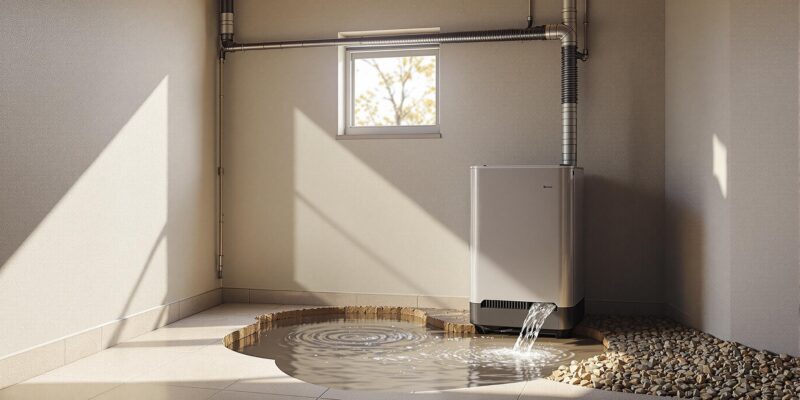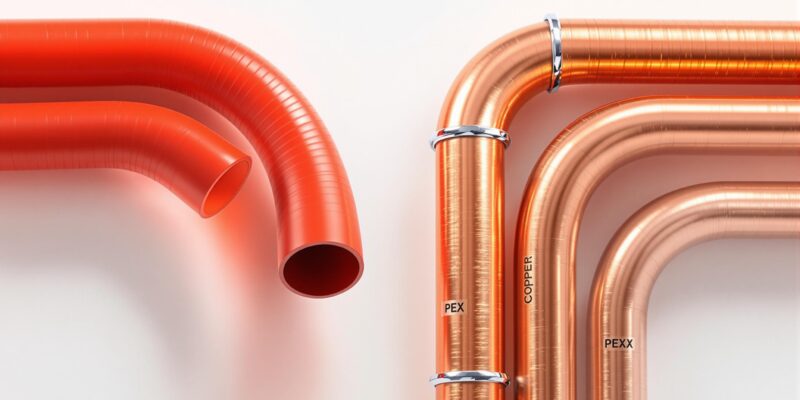Ultimate Guide to Sump Pump Sizing and Selection
Choosing the right sump pump is essential to prevent basement flooding and avoid costly water damage. Here’s what you need to know:
- Pump Types:
- Submersible: Quiet, handles high water volume, fits deep pits.
- Pedestal: Affordable, easier to maintain, ideal for narrow pits.
- Battery Backup: Activates during power outages for added protection.
- Sizing Your Pump:
- Measure vertical lift (height from sump pit to discharge point) and horizontal distance.
- Match flow rate (GPM) with pump power (HP).
- Use proper pipe size to minimize friction loss.
- Key Features:
- High-water alarm, check valve, and battery backup ensure reliability.
- Professional Installation: Certified technicians ensure proper setup, extending pump lifespan and reducing risks.
Follow this guide to select, size, and install a sump pump that fits your needs, ensuring long-term protection for your home.
Sump Pump Types
Main Pump Types: Submersible, Pedestal, and Battery Backup
Submersible Pumps
These pumps combine the motor and pump into a single waterproof unit, allowing them to operate fully submerged in the sump pit. They are quiet, compact, and handle larger volumes of water and debris effectively.
Pedestal Pumps
A pedestal pump has its motor positioned above the sump pit, with only the pump section submerged. While they are louder than submersible pumps, they are more affordable and easier to maintain. Their slim design makes them ideal for narrow or shallow sump pits.
Battery Backup Systems
Battery backup pumps act as a secondary layer of protection, automatically activating during power outages or when the primary pump fails. They help prevent flooding until power is restored or the main pump is repaired.
Selecting Your Pump Type
Choosing the right pump depends on your specific needs and the conditions of your space.
Site and Flow Requirements
- For finished basements with expensive flooring or stored items, a quiet submersible pump paired with a battery backup offers reliable protection.
- If water seepage is light to moderate, a pedestal pump can handle the job efficiently.
- For areas prone to heavy water flow or frequent flooding, a submersible pump provides the necessary capacity to manage the load.
Installation Space
Check the dimensions of your sump pit to ensure the pump fits properly. Submersible pumps require a deeper pit, while pedestal pumps need enough vertical space above the pit for the motor.
Once you’ve determined the type of pump you need, it’s time to focus on sizing it correctly.
How to Choose a Sump Pump? (Complete Sizing Guide …
How to Size Your Sump Pump
Choosing the right sump pump depends on two main factors: total dynamic head (which includes vertical lift, horizontal distance, and friction losses) and the required flow rate. Once you know the pump style you need, it’s time to calculate these variables to ensure the pump fits your setup.
Measuring Lift and Distance
To determine the total dynamic head, start by measuring the vertical lift – the height from the bottom of your sump pit to the discharge point. Then, add the length of the horizontal pipe and account for any elevation changes along the way.
For example, if you have an 8-foot pit and a 20-foot horizontal pipe, you’ll need a pump rated for at least 28 feet of head to handle the lift and friction.
Flow Rate and Power Requirements
Your pump should be able to handle the maximum amount of water your site might experience. Here’s a breakdown of flow rates and the corresponding pump power you’ll need:
| Water Flow | Total Head (ft) | Minimum HP |
|---|---|---|
| Light (15–25 GPM) | Up to 15 | 1/3 HP |
| Moderate (25–45 GPM) | 15–25 | 1/2 HP |
| Heavy (45–60+ GPM) | 25+ | 3/4 HP |
Pipe Size and Friction Loss
The diameter of your discharge pipe directly impacts friction loss. Here’s a quick guide:
- Use 1.25-inch pipes for flows up to 30 GPM.
- Use 1.5-inch pipes for flows between 30 and 45 GPM.
- Use 2-inch pipes for flows above 45 GPM.
Keep in mind that every 90-degree elbow in the piping adds around 2 feet of head. To reduce friction and maintain efficiency, minimize bends or consider upsizing the pipe or selecting a pump with a higher head rating for longer or more complex runs.
What to Look for When Buying
Once you’ve calculated pump capacity and head, it’s time to ensure your chosen model is equipped with the right safety features.
Double-Check Your Sizing Calculations
Match your total dynamic head and flow-rate measurements to the pump specifications to ensure compatibility.
Key Safety Features to Consider
Make sure your pump includes these essential safety features:
- High-water alarm: Alerts you when water reaches critical levels.
- Check valve: Stops water from flowing back into the pump.
- Battery backup: Keeps the pump running during power outages.
Pump Features Compared
Once you’ve determined the right size and safety features, it’s time to compare pump models side by side. With your pump type selected and sizing calculations complete, focus on the key features and power ratings to make your final choice.
Pump Types and Their Applications
- Submersible: Operates quietly, handles high water volumes, and is ideal for deep pits due to its sealed motor.
- Pedestal: More affordable and easier to service, though it’s noisier and best suited for narrow pits.
- Battery Backup: Automatically activates during power outages, but offers limited flow and is best for emergencies.
Consider how these features align with your calculated head and flow rate to ensure the pump performs reliably.
Power and Flow Rate Considerations
Check that the motor power aligns with your flow-and-head calculations. Match the pump’s horsepower (HP) and gallons per minute (GPM) ratings to the head and flow you measured. Use the manufacturer’s performance curve to confirm the pump will operate effectively under your specific conditions.
Choose a pump with a capacity that matches your usual water volume, leaving some extra room for heavy rainfall or unexpected water inflows. This ensures your system can handle peak demands without fail.
Expert Installation and Support
Once you’ve selected the right pump, proper installation and support are essential for optimal performance.
Why Opt for Professional Installation
Professional installation ensures your system operates reliably. Certified technicians handle everything: confirming lift and flow calculations, positioning the pump correctly, making safe electrical connections, adhering to local regulations, and testing the system under real-world conditions. This process helps avoid costly installation mistakes.
Hydrodynamics’ Services
Hydrodynamics Inc., a family-run business since 1994, specializes in sump pump installation and support. Their team of certified technicians carries qualifications like A.S.S.E. Backflow Testing, EPA 609, and Trac Pipe & Gas Tite certifications. Key services include:
- Sump Pump Installation: Expert setup by experienced professionals
- Preventative Maintenance: Routine inspections and performance tests to keep your system running smoothly
Emma K. from Drums, PA, had this to say about her experience:
“They were prompt and knowledgeable and efficient. Very pleased with their work.”[1]
Choosing certified professionals not only ensures your pump performs at its best but also extends its lifespan and reduces the chance of unexpected repairs.
Conclusion
Choosing the right sump pump size is key to preventing basement flooding and expensive water damage. Consider the pump type, lift-and-flow requirements, and professional installation to ensure it works effectively. Hydrodynamics Inc. offers certified technicians who specialize in sizing, installation, and maintenance, providing reliable protection for the long haul. Protect your home and avoid costly repairs by opting for expert pump selection and installation.



